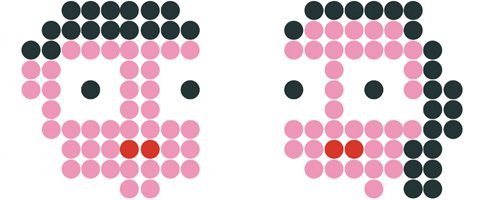The pixel is an unfixed unit of measure; on the computer, it is the smallest unit of visual information that can be used to build an image. Yet it has an extremely tangible quality. Sometimes, I feel mediated by the pixel. If I work long at a computer and move away, I find myself measuring my world in pixels: the height of a building, the pattern of a cloud, the distance between lips about to kiss.
There is a relationship between tile mosaics and pixels. Working in Istanbul, I dream of Byzantium, opulently tiled, fixed in the canons of art history as an empire that synthesized a multiethnic mosaic under the rubric of Christianity, and celebrated/replicated as poems, postcards, and souvenir plates. This period of art resonates in imaginative space; its religious core allows it to coexist in dazzling high art and pop cultural forms. The iconography of the Byzantine Empire propagated the newly legalized Christian mythology and took from the East its stylistic severity, rhythmically geometric figural forms, stiff and formal simplicity, and strong, frontal bodies free of any background images. Specific to Man + Woman is the iconography of Adam and Eve, the seminal bible story, the heart of Creationism, the original couple, the binary unit, and the biological imperative.
Byzantium had its own polarities, a coexistent east and west. Then the west ate the east. What seems coherent to us now was cacophonous and unfolded over a millennium (imagine!). Today, there is tension between the values of what is old and new, eternal and ephemeral. Some of this tension is recent and is borne from the speed of the copy, the density of the copiesí propagated forms, and the intensity of colors in the pop world in which we live. I am interested in bringing the pixel into the physical world in order to create feedback loops among these inputs and outputs.
I’m playing with the most pleasurable aspects of the digital world: flat expanses of bright candy colors and a spectrum of toy-like tools. In the real (pop) world, I make pixels out of plastic, low-brow and low-income, prefabricated modules that are associated with disposable culture and .99 cent stores: brightly colored bowls and storage bins, milk crates, cheap baubles. Polymers are a magical, malleable unit, capable of transformation. Plastic is considered disposable, yet it never degrades. The ephemeral embodies an unwanted eternal; the enduring is upended.


